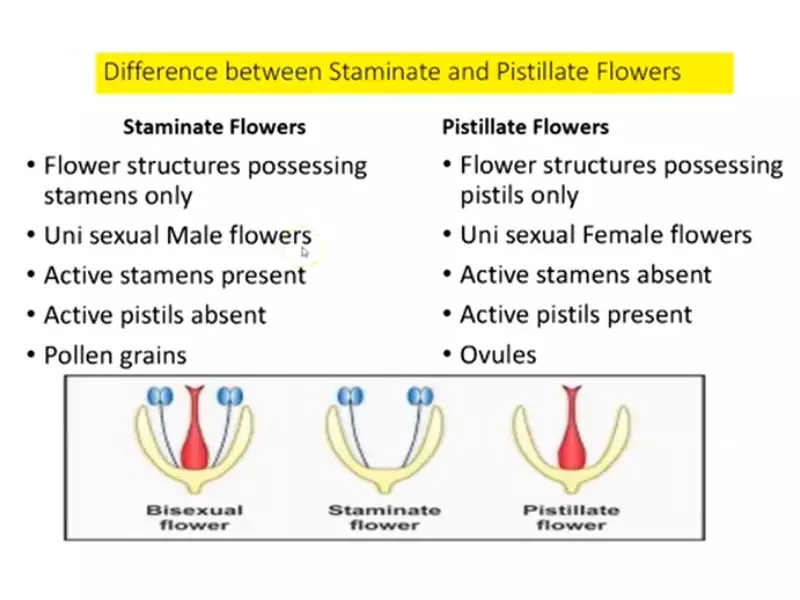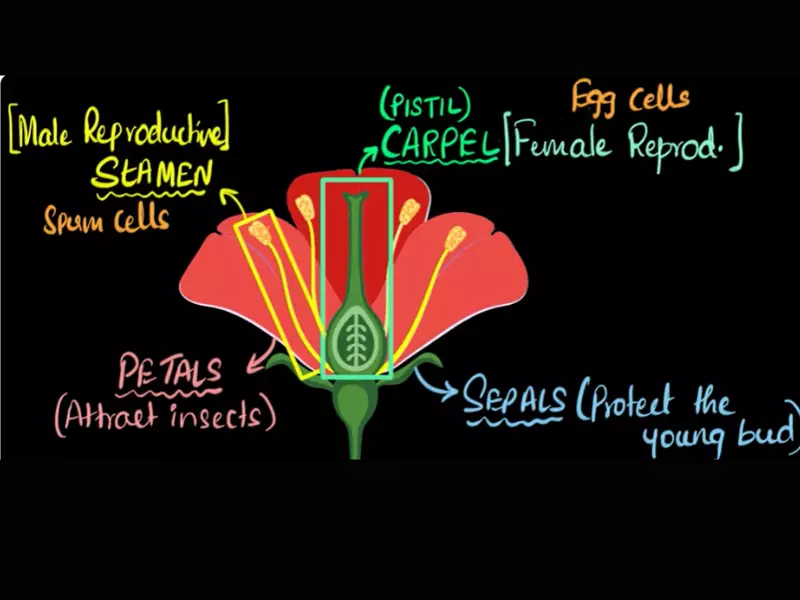Flowering plants are marvels of the natural world, presenting a diverse array of colors, shapes, and sizes. Central to their beauty and biological function are two critical structures: the stamen and the pistil. These components are not just mere parts of a flower’s anatomy; they are the heart of the plant’s reproductive system, facilitating the process of pollination and ensuring the continuation of plant species.
The stamen and pistil serve distinct roles in plant reproduction. The stamen is the male reproductive organ of a flower, consisting of an anther and a filament, responsible for producing and dispersing pollen. On the other hand, the pistil, the female reproductive part, includes the stigma, style, and ovary, and plays a crucial role in receiving pollen and housing the ovules that develop into seeds after fertilization.
Understanding the difference between the stamen and pistil goes beyond basic botany; it’s about appreciating the intricacies of plant life and the mechanisms that sustain biodiversity. These structures exemplify nature’s ingenious strategies for survival, showcasing how plants have evolved to optimize their reproductive success through various means of pollination and fertilization.

Stamen: The Male Part
Definition and Role
The stamen is the male reproductive part of a flower. Its primary role is to produce and disperse pollen, which contains male gametes necessary for fertilizing the female part of the flower, the pistil. The successful transfer of pollen from stamen to pistil is a vital step in the reproduction of flowering plants.
Components of Stamen
The stamen consists of two main components:
Anther
- The anther is where pollen is produced. It sits atop a thin stalk known as the filament.
- Inside the anther, pollen grains develop, each containing male reproductive cells.
Filament
- The filament is a slender stalk that supports the anther.
- It positions the anther in a way that maximizes the chances of pollen dispersal to the pistil.
Function of Stamen
The function of the stamen revolves around the production, housing, and dispersal of pollen. Pollen dispersal can occur through various means, including wind, water, or animal pollinators, such as bees and butterflies. The goal is for the pollen to reach the pistil of the same or another flower, facilitating fertilization.
Pistil: The Female Counterpart
Definition and Role
The pistil is the female reproductive part of a flower. It’s designed to receive pollen, facilitate its germination, and ensure that fertilization occurs within the ovary, leading to the production of seeds.
Components of Pistil
The pistil is composed of three main parts:
Stigma
- The stigma is the sticky tip of the pistil. It captures and holds onto pollen grains.
Style
- The style is a slender column that connects the stigma to the ovary.
- It provides the pathway for pollen tubes to grow from germinated pollen grains on the stigma down to the ovary.
Ovary
- The ovary is the enlarged base of the pistil.
- It contains one or more ovules, which, upon fertilization, develop into seeds.
Function of Pistil
The pistil’s function is multifaceted, involving the capture of pollen, facilitation of fertilization, and nurturing of developing seeds. It ensures that pollen reaches the ovules within the ovary for successful fertilization to occur, a process essential for the production of the next generation of plants.
Key Differences
Structural Distinctions
While both the stamen and pistil are fundamental to a flower’s reproductive process, they differ significantly in structure. The stamen is composed of the anther and filament, focusing on pollen production and dispersal. In contrast, the pistil, consisting of the stigma, style, and ovary, is geared towards receiving pollen and facilitating the development of seeds.
Functional Roles in Plant Reproduction
The stamen and pistil play complementary roles in plant reproduction. The stamen’s role is to produce and disperse pollen, whereas the pistil’s role is to receive this pollen, facilitate fertilization, and nurture the developing seeds.
Interaction in Pollination Process
The interaction between stamen and pistil during pollination is a key aspect of plant reproduction. Pollen must be transferred from the stamen to the stigma of the pistil, where it can germinate and fertilize the ovules. This interaction can occur within the same flower, between flowers on the same plant, or between flowers on different plants, depending on the species.
Similarities and Interactions
Essential for Plant Reproduction
Both the stamen and pistil are essential for the reproduction of flowering plants. Without either part, the process of pollination and fertilization could not occur, preventing the formation of seeds and the propagation of plant species.
How They Work Together in the Pollination Process
The stamen and pistil work together seamlessly in the pollination process:
- Pollen production: The stamen produces pollen that needs to be transferred to a pistil.
- Pollen capture and fertilization: The pistil captures pollen on its stigma, then facilitates its travel to the ovary where fertilization occurs.
Visual Guide
Identifying Stamen and Pistil in Flowers
To help readers identify the stamen and pistil in flowers, consider the following visual cues:
- Stamen: Look for the anther and filament. The anther typically carries pollen and may appear as a small, often dust-like structure. The filament is a thin stalk that supports the anther.
- Pistil: Identify the stigma, style, and ovary. The stigma is often sticky or feathery to capture pollen. The style is a slender stalk leading down to the ovary, which is usually at the base of the pistil.
This visual guide underscores the distinct appearances and roles of the stamen and pistil, facilitating a deeper understanding of their contributions to plant reproduction.

Role in Plant Reproduction
Pollination
Pollination is the act of transferring pollen from the stamen (the male reproductive organ) to the pistil (the female reproductive organ). This crucial process can occur in two main ways: self-pollination and cross-pollination.
Self-pollination
Self-pollination happens when pollen from a flower’s stamen fertilizes the ovules in the same flower’s pistil or another flower on the same plant. While this method ensures a high probability of pollination, it limits genetic diversity since the plant is essentially breeding with itself.
- Advantages include less reliance on pollinators and consistent reproduction in isolated areas.
- It occurs in plants with flowers that can fertilize themselves internally or through close proximity of stamen and pistil.
Cross-pollination
Cross-pollination involves the transfer of pollen from the stamen of one plant to the pistil of another plant of the same species. This method promotes genetic diversity, which can lead to stronger, healthier populations of plants.
- Requires pollinators like bees, birds, wind, or water.
- Leads to greater genetic variation, which enhances resilience and adaptability.
Fertilization Process
After pollination, the pollen grain germinates on the stigma, grows a pollen tube through the style, and reaches the ovary where it fertilizes an ovule. This fertilization marks the beginning of seed development.
- The fertilized ovule becomes the seed.
- The ovary often develops into fruit, enclosing the seed(s).
Seed and Fruit Formation
The formation of seeds is a pivotal event in the life cycle of a flowering plant. After fertilization, the ovule develops into a seed, containing the embryo that can grow into a new plant. The ovary, meanwhile, may grow into a fruit, which aids in seed dispersal.
- Seeds contain nutrients for the embryo’s initial growth.
- Fruits can facilitate dispersal by attracting animals or adapting to environmental forces like wind or water.
Evolutionary Significance
Evolution of Flowering Plants
Flowering plants, or angiosperms, have evolved over millions of years from simple structures to the complex organisms we see today. Their ability to reproduce through flowers has been a key factor in their success and diversification.
- Angiosperms are the most diverse plant group on Earth.
- Flowers allow for efficient reproduction and rapid adaptation to environmental changes.
Adaptations for Successful Reproduction
Over time, flowering plants have developed numerous adaptations to ensure successful reproduction. These include variations in flower color, shape, and scent to attract specific pollinators, as well as timing of flowering to coincide with pollinator activity.
- Nectar guides and scent attract specific pollinators.
- Temporal isolation ensures flowers bloom when pollinators are most active.
Importance in Horticulture and Agriculture
Breeding Programs
Breeding programs in horticulture and agriculture utilize the principles of stamen and pistil interaction to create plants with desirable traits. By selecting plants with specific characteristics for breeding, scientists and farmers can produce varieties that are more resilient, productive, and appealing.
- Focus on traits like disease resistance, yield, and aesthetic appeal.
- Utilize both self-pollination and cross-pollination techniques.
Crop Improvement Strategies
Improving crop varieties is essential for food security and agriculture sustainability. By understanding the reproductive biology of plants, agronomists can devise strategies to enhance crop yields, improve nutritional value, and ensure resistance to pests and diseases.
- Genetic modification and hybridization are common techniques.
- Strategies aim to increase efficiency of water and nutrient use.
Conservation Efforts
The knowledge of plant reproduction is also crucial for conservation efforts. Protecting the diversity of plant life ensures ecosystems remain resilient and functional. Conservationists work to preserve rare and endangered plant species, many of which have unique reproductive mechanisms.
- Seed banks and botanical gardens play a key role in conserving genetic diversity.
- Restoration ecology often involves reintroducing plants with specific reproductive traits to stabilize ecosystems.
FAQs
What is the main function of the stamen?
The stamen’s main function is to produce and release pollen, which contains the male gametes necessary for fertilization. The anther, part of the stamen, develops pollen grains, while the filament positions the anther to effectively disperse pollen to the pistil of the same or another flower.
How does the pistil contribute to plant reproduction?
The pistil contributes to plant reproduction by receiving pollen on the stigma, facilitating its journey down the style to the ovary, where fertilization occurs. Within the ovary, the ovules, which contain the female gametes, are fertilized by male gametes from the pollen, leading to the development of seeds.
Can a flower have both stamen and pistil?
Yes, many flowers have both stamen and pistil, making them bisexual or hermaphroditic. This arrangement allows for self-pollination or cross-pollination, enhancing the plant’s ability to reproduce. However, some plants produce unisexual flowers, which contain either stamen or pistil, necessitating cross-pollination for reproduction.
Why is pollination important for plants?
Pollination is crucial for the reproduction of most flowering plants. It involves the transfer of pollen from the stamen to the pistil, enabling fertilization and the subsequent formation of seeds. Pollination can occur through various agents, including insects, birds, wind, and water, and is essential for the genetic diversity and survival of plant species.
Conclusion
The stamen and pistil are not merely components of a flower’s anatomy but the keystones of plant reproduction, symbolizing the complexity and diversity of life itself. Their roles and interactions underscore the evolutionary adaptations plants have developed to ensure their survival and proliferation. By understanding the differences and functions of the stamen and pistil, we gain insights into the fundamental processes that sustain the floral world and, by extension, the ecosystems that depend on plants.
As we conclude, it’s clear that the stamen and pistil represent more than just parts of a flower; they are a testament to nature’s ingenuity in fostering life. Through the lens of these reproductive structures, we can appreciate the broader story of adaptation, survival, and biodiversity that characterizes our planet’s flora.
